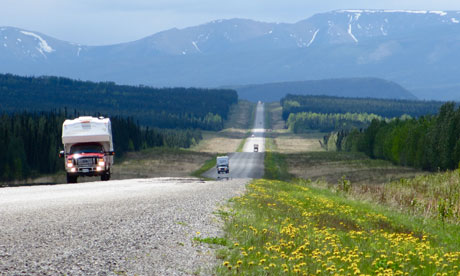
There is something about a highway through the wilderness that attracts eccentrics. The 1,500-mile Alaska Highway, which crosses British Columbia and the Yukon for most of its route, has its fair share. Even the construction of the road, which turned 70 last year, was anything but normal.
US soldiers were ordered to build the road – described as one of the greatest engineering feats in history – through unmapped territory. They endured extreme cold, mud and mosquito-infested forests. The highway, which joined the contiguous US with Alaska, was a response to the attack on Pearl Harbor. It enabled the Americans to transport planes to Russia to fight the Germans, via a chain of airfields and remote airports. Remarkably, it was built in just eight months, carved through rock and forest from Dawson Creek in BC to Delta Junction in Alaska, providing a wartime morale boost for the US.
The characters who live along the route are every bit as fascinating as the story of its construction. Marl Brown, the 80-year-old curator of the Fort Nelson Heritage Museum in northern BC, sports a long white beard because, he says, he hates shaving. The former mechanic's collection of vintage cars was the inspiration for the museum. His favourite is the 104-year-old McLaughlin Buick with its "mother-in-law seat" that can tip the rear passenger out the back.
At Double G Services near Muncho Lake, three hours west, truckers share road tales of bobcats, lynx and grizzlies. There are shelves of fresh bread and an Alaska licence plate with a picture of Sarah Palin, which reads: "Where the air is cold and the governor is hot!" They agree both caribou and tourists are stupid, and discuss the merits of a moose bumper.
More than 300,000 people drive the Alaska Highway every year between May and September and, as the last US frontier, it is on the to-do list of many Americans. There are bears, wild sheep, bison and moose to photograph, against a backdrop of increasingly spectacular mountains as you travel north and west.
At Liard Hot Springs RV Park on the eastern edge of BC, we had soaked in the waters with full-time RVers – people who have sold their homes in retirement and are on the move constantly.
"You have to really get on well with your partner to do this," warns one.
Many have their dogs along for the ride – yorkshire terriers and pomeranians are being exercised all along the highway.
A woman named Button (her mother loved the actor Red Buttons) oversees the Signpost Forest Visitor Centre at Watson Lake, over the border in the Yukon. In 1942, a lonely GI working on the highway started the tradition of leaving a sign pointing the way home. More than 70,000 signs have since been left here by travellers on the road.
Every road trip needs good snacks. Look out for cinnamon buns at Tetsa River RV Park , west of Fort Nelson, and the Canadian favourite "butter tarts" at the Yukon's Rancheria Lodge. The lodge has a long history of sheltering travellers from storms. It hosted 100 unexpected guests last year when the road was washed away in a flash flood. Stories from the 1940s tell of strangers having to sleep two to a bed.
There is a quirkiness to road-stops here. At the Toad River Lodge in northern BC, you can eat a toad burger (which comes with a hot dog, too) under a ceiling covered in baseball caps, or drink a coffee while a stuffed wolverine watches over you at the Yukon Motel on Teslin Lake.
We spot a moose at Sikanni River RV Campground. Campsite owner Jackie says it is called Dandelion, and appears every summer. Soldiers from black regiments built a bridge in record time here, an achievement credited with helping end segregation in the US army.
John Rusyniak, who runs the Wilderness Lodge in Tok, Alaska, got a taste for the north when he rode his motorbike up the highway in the 1970s and moved there. Many have similar stories.
There is plenty to do along the way – fishing in holes, panning for gold at the MacBride Museum in Whitehorse, daring to walk the Pouce Coupe trestle bridge, the Alaska Highway House museum in Dawson Creek and the sausage rolls at Johnson's Crossing Bakery – but it is the memory of people of the Alaska Highway that will stay with me.

